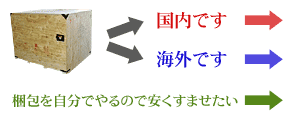米国税関、ISPM No.15 違反の輸入木製梱包材に罰金課徴 ISPM REPORT
| 燻蒸不要のLVL材が必要な場合は燻蒸不要のLVL販売ページへ |
| この情報は社団法人日本荷主協会様の許可をいただいて木製梱包の検疫などに関する情報を掲載させていただいております。 |
|
米国税関、ISPM No.15 違反の輸入木製梱包材に罰金課徴
|
2007年3月12日(月) |
International Standards for Phytosanitary Measures ISPM REPORT No.07‐05
|
米国税関・国境警備局(US Customs and Boarder Protection)は3月9日実施で、米国輸入規則に違反した輸入木製梱包材には、輸入者または船社などの運送人・通関業者・フォワーダーやNVOCC などの貨物管理者から損害賠償金ないし罰金を徴集することもありうると発表しました。しかし、これは海外の輸出者や梱包業者に対する罰金ではありません。 米国では2006年7月5日からISPM No.15に基づいた輸入木製梱包材規則が完全実施になっていますが、この完全実施までには三段階のステップを経てきたものです。今の時点で、なぜこのような罰金徴集の発表になったのかは定かでありませんが、米国規則では、世界のほかの国と違って違反梱包材の国内消毒処理は認められておらず、全て再輸出(積戻し)処分となります。 この違反梱包材とは、マークのないもの、不適切なマークのもの、マークがあっても害虫がいるもの、などのことですが、再輸出に伴う全ての費用は違反者に帰すことになっています。 ところが、私見ながら、違反者の特定が難しいこともあるので、この費用確保のために輸入者・船社・通関業者・NVO などが税関に対して積んでいる保証金または保証金保険から、罰金を徴収することもある旨を示したものではないかと思われます。 いざ、積戻しや再輸出になれば、米国の輸入者は海外の輸出者に対してその罰金等の費用を請求するのみならず、商品代金の返還・契約不履行による損害・遅延による損害などを賠償請求することもありえましょう。 特に、コンテナ内のダンネージ材や、鋼材船などの在来船内ダンネージ材について検査規則が厳しく適用されると、膨大な違反事例が出現するものと危惧されます。 米国の輸入港で厳しい木製梱包材検査を行えば、通常でさえ混んでいるコンテナ港を混乱におとしめることになりましょう。 コンテナ内のダンネージまで厳しくマークの有無を検査されては、我国の認証スタンプ制度では、作業会社や運送会社ではスタンプを持てないので、十分に対応しきれないおそれがあります。 いきおい、ダンネージなしの危険なコンテナ輸送が増えてしまうと、大陸横断トラックやダブルスタックトレインが転覆事故を続発させれば、米国経済への影響はテロリストの攻撃にも匹敵するものになるでしょう。 よもや、米国税関がこんな血迷ったことをする筈はないものと、期待しましょう。 |
 |
 |
************************************************************* 次に米国税関のWebsite に載っている GUIDELINES FOR LIQUIDATED DAMAGES AND PENALTIES ON WOOD PACKING MATERIAL (WPM) 「木製梱包材に関する損害賠償および罰金のガイドライン」 原文をご参考までに掲載します。 *************************************************************
|
|
GUIDELINES FOR LIQUIDATED DAMAGES AND PENALTIES
ON WOOD PACKING MATERIAL (WPM) These “Guidelines for Liquidated Damages and Penalties on WPM” shall go into effect on March 9, 2007. The statutory requirements of 7 C.F.R. §319.40-3 mandate that regulated WPM ? such as, crates, boxes, and pieces of wood used to support or brace cargo ? being imported into the United States shall be heat treated or fumigated with methyl bromide in accordance with EPA label instructions and include a mark that certifies the wood completed the required treatment under the “Guidelines for Regulating Wood Packing Material in International Trade,” ISPM 15 of the International Standards of Phytosanitary Measures (ISPM) and any associated amendments, revisions or exemptions identified by the U.S. Department of Agriculture, Animal and Plant Health Inspection Service (APHIS). The regulation (7 C.F.R. §319.40-3) requires that WPM display a visible, legible, and permanent mark certifying treatment. The mark must be a legible and permanent mark that indicates that the article has been subjected to the approved measure and include the following elements:
|
Here is an example of an acceptable WPM mark:
 The IPPC logo is on the left; on the right, XX represents the ISO country code and 000 represents the unique number assigned to the producer of the wood packaging material in order to be able to trace back to the treatment facility used; YY represents the method of treatment. Other letters and symbols may be present on the mark as long as the above items are included and clearly legible, permanent, and placed in a visible location, preferably on at least two sides of the article being certified. |
| EXCEPTIONS AND EXEMPTIONS The regulation applies to WPM made from softwood or hardwood. Certain articles, though, are exempt or excepted from the treatment and marking requirements. The exceptions are outlined in 7 C.F.R. §319.40-3. The exceptions and exemptions (further added by Agriculture) are delineated in Appendix B of the CBP document entitled “Operating Procedures for Implementation of the Wood Packaging Materials (WPM) Regulation,” as amended. This may be viewed on the import section of cbp.gov under Commercial Enforcement. |
|
FAILURE TO COMPLY WITH 7 C.F.R. §319.40-3 Regulated WPM must be properly marked to indicate that it has been either heat treated or treated with methyl bromide. There are three categories under WPM for this enforcement:
Section 319.40-3(b)(3) provides for immediate export of WPM that does not contain the required mark. Marked WPM containing pests in the above mentioned families is considered WPM that has not been treated and marked in accordance with §319.40-3, and shall be immediately exported pursuant to §319.40-3(b)(3). The importer of record, carrier, or bonded custodian is responsible for any costs or charges associated with export. When assessing liquidated damages and/or penalties, the value of the merchandise is the value of the WPM plus the value of the commodity or commodities identified for importation on the entry documentation. |
|
ASSESSING LIQUIDATED DAMAGES If the party whose bond is obligated at the time of the discovery of the violation has received an Emergency Action Notification (EAN) requiring export of the violative WPM but fails to do so, CBP may issue a liquidated damages claim against that party. The following procedures shall be utilized in liquidated damage cases where there is a failure to comply with the EAN:
|
|
ASSESSING PENALTIES Penalties may be assessed in addition to claims for liquidated damages, and may be assessed even though there is compliance with all EANs in cases wherein:
WPM violations (all categories) shall be documented in the EAN database, and WPM violations under categories 1 and 2 shall be documented in CBP databases with the WPM violation code wp:nc. |
ISPM 15 REQUIREMENTS APPLY TO ALL SPECIES OF CONIFEROUS (SOFTWOOD) AND NON-CONIFEROUS (HARDWOOD) PACKAGING MATERIALS.
  |
お問い合わせはinfo@konpo.netまで |
| ● 梱包サービスについてのQ&A | |||
 |
|
 |
|
 |

